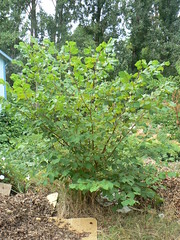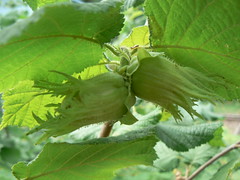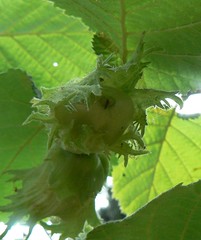
My hazelnut tree, which I raised from a seedling, finally has nuts on it! There are only two of them, but I'm still excited. Every year for the last few years I've checked the tree for signs of nuts, only to be disappointed--and now it finally has some. Here they are--aren't they cute?

This pic shows the immature nut inside the husk:

Where I live used to contain a hazelnut orchard many years ago (or so the neighborhood old-timers tell me), so there are lots of hazelnut trees in the area. The squirrels bury the nuts and forget to eat some of them, so they sprout, and we end up with lots of hazelnut seedlings in the yard. I decided to keep a couple of them, one male and one female. The male has been producing catkins for several years, and now the female is finally reproductive age too. Yay! My hazelnuts have reached puberty!
Hazelnuts are very easy to grow, though it can be a challenge to find trees for sale or even to find information on growing them. A Google search turned up a few links with information, including these two:
- Introductory article from Martin's Yard & Garden
- Harvesting, Handling and Storing Nuts from the Home Orchard (pdf from Oregon State University Extension Service)
Neither gives clear growing instructions, so I'll include some here.
Growing conditions
Hazelnut (a/k/a filbert) trees are understory trees, so they can tolerate some shade. Mine grow in anywhere from nearly full sun to half shade. They're extremely low-maintenance, requiring little to no supplemental water here in Portland. They appreciate a little fertilizer but don't require it. They seem fine with our local heavy clay soil, though I mulch mine with compost and fall leaves.
Males and females
A male and female are required for nuts, and only females produce nuts (I'm sure there's a joke in there somewhere, but I'm not going to search for it). As long as there's a male tree somewhere in the area, the female should bear. I'm not sure how close together they need to be; mine are about 40 feet apart, but I don't think they need to be that close. When they are seedlings, males and females look the same. After a few years, males will start producing catkins (sort of furry, worm-like things, about 2-3" long--there's probably a joke in there somewhere too) in late fall. These will hang on the bare branches throughout most of the winter. I don't have any pictures of my male hazelnut, but there are a few good ones on Flickr, including this one.
Getting trees
As for finding trees... good luck. Until recently, it was illegal to sell hazelnut trees in Oregon or ship them to Oregon, because of efforts to control Eastern Filbert Blight. The ban was lifted a couple of years ago, when attempts to control the disease proved futile. The change wasn't well-publicized, however, so most nurseries still don't sell them. So how do you get one?
- If you know someone with a filbert, you can ask for a sucker from it (they spread into thickets).
- If you live near filbert trees, you'll probably end up with seedlings in your yard, but you may mistake them for weeds, as I used to. A Flickr seearch on hazelnut leaves turns up some pictures that can help you recognize baby trees. If you aren't sure, gently dig up a likely candidate and check the roots for the remains of the hazelnut. If the seedling is small (less than about 12" tall), part of the nut should still be there.
- If you don't want to go to all this trouble, leave a comment with your email address, and I'll make arrangements to send you some seedlings. I have several in my yard that I need to dig up.
- Finally, you can grow your own from fresh, raw hazelnuts. Just bury the nut and wait. But be patient. My female filbert is about 6 years old, and it's just now starting to produce nuts.


38 comments:
Whoa, Janet!
Please don't propagate seedling filberts; contact a nursery, such as the online Raintree Nursery and order blight immune cultivars.
Some foundling seedlings have very susceptible parents, and by bringing them into an area you can further spread the disease; which is very irresponsible. Or you can grow the indigenous wild Pacific filbert Corylus cornuta californica, which is either immune or extremely resistant. These are available through a wide range of sources.
One other thing; the restrictions were lifted NOT because control efforts had failed; but because blight immune varieties have become available.
Please people, don't spread plant diseases; if you are interested in a plant that is likely to be infected with some horrible disease talk to your county extension agent and have them advise you on resistant and/or immune cultivars.
Your local farmers will thank you and there land won't turn into another strip mall or apartment complex.
This site explains why it is important to NOT propagate susceptible cultivars; including escaped seedlings.
Tiny URL:
http://tinyurl.com/2rj7zs
Long form, for the less trusting:
http://oregonstate.edu/dept/botany/epp/EFB/management/destroy.htm
a reliable and affordable source for these trees is the Arbor Day Foundation http://www.arborday.org or more specifically http://www.arborday.org/Shopping/Trees/Treelist.cfm?Categories=4
I really appreciate all the comments on this post. I don't know whether my trees are the indigenous variety or the cultivated, and possibly susceptible, variety. I'm guessing the latter, because old-timers in the area tell me that my neighborhood used to be a filbert orchard. What I do know is that there are many filbert trees in my neighborhood, and I have yet to see one that shows any sign of disease. I know that isn't a guarantee, but the evidence is pretty suggestive. I don't plan to propagate any more, but as long as the ones I have seem healthy, I'm not convinced I should remove them.
Hello Janet, I live in north portland and was cleaning blackberries out of my back yard when low an behold- I pulled up a little hazelnut tree. I got very excited and have been trying find out how to cultivate it. Any tips? How do you tell a male from a female? Right now the seedling is about 6 inches high. Also I haven't noticed any diseased trees in my neighborhood. Any advice or help would be helpful- thanks- mika
To the last anonymous poster: Congrats on finding a hazelnut seedling! They're easy to cultivate. Just plant it in sun to about half shade and keep it watered till it's well-established. You can't tell male from female till it produces either nuts or catkins, but I have a couple trees that seem to have both male and female branches. Hermaphroditic hazelnuts... sounds like a good name for a punk band :-)
As for the disease issue, I don't know what to tell you. The people who left the previous comments seem awfully sure about this issue, but I have yet to see a diseased tree around here. You might check with a reliable nursery to be sure.
Good luck!
hey I got a question my filbert tree has hundreds of nuts but how do you tell when they are ready
I found a document on the Oregon State University Extension site that covers harvesting, handling, and storage of hazelnuts and other nuts. See http://extension.oregonstate.edu/umatilla/mf/sites/default/files/Harvesting__Handling___Storage_fs146.pdf. According to that document, you should gather your hazelnuts after they fall to the ground.
I live in Windsor, Ontario (just north of Detroit, Michigan) and have hazelnut trees/bushes in my yard. In the near future I plan to move and want to 'take' the hazel nuts with me and am open to helpful suggestions.
I saved some nuts from this year's harvest. I am also considering starting plants from cuttings from the existing bushes. I will try anything to ensure that I have plants (bushes/trees) at my new home. Nurseries and growers in this area do not carry hazelnut plants so ANY suggestions would be greatly appreciated.
Hi, Cara,
I'm not an expert on propagating hazelnuts, since mine spring up on their own. You could plant some of the nuts you saved, but given the concerns other posters have expressed about filbert blight, your best bet is probably to purchase young trees from a reputable nursery. I don't have experience with mail-order nurseries in Canada, so I can't recommend a specific source. I did find at least one (http://www.nuttrees.com/other_edible.htm) that stocks hazelnut trees, and I also found a guide to mail-order nurseries in Canada (http://users.adelphia.net/~johnsonjames/Canadian.htm). I hope that helps.
Corylus doesn't have a male or female tree.
There are male and female flowers on the same tree. The males are long catkins, the female ones are little buds with some bristles sticking out. The pollen from the male needs to get to the female flowers. The wind takes care of that. There is only one catch; flowers from the same tree don't pollinate each other. You need another tree nearby for this, one that blooms at the same time.
Many thanks to the last anonymous poster for explaining the male/female thing! Most of the information I found talked about male and female trees, which is why my original post talked about that, but it doesn't gibe with my experience. I have trees that produce both nuts and catkins, and now I know why. Thanks very much!
Janet:
please tell me how to plant hazelnut from seed? with shell or without?
how deep? what season? how long would it take to see srouts from seeds?
plant the seed on ground or in pot?
will be very appreciated to have your reply back to my e-mail address>>> faridg@sbcglobal.net
Thank you
Fred/Irvine,Ca
Fred, I'll send you a reply via email too, but I'll also reply here. As you can see from the comments on this post, there is some controversy about whether you should propagate hazelnuts from seed at all. I'll leave that to your good judgment. I'm not an expert on growing hazelnuts from seed, because the squirrels plant mine. But the ones that seem to grow best have the seed (shell left on) buried about 3" deep. I don't know how long they take to germinate, so I'd say plant it, keep it moist and cool (our climate here is cool and wet) and be patient.
Janet, I would like to try and grow some type of nut tree/bush the problem is I think I may live too far north. I live in Edmonton AB, Canada. Please send to d_14_02_62@yahoo.com suggestions as to what will survive and produce.
Janet, would it be possible to get some of your seedlings? I have tried all over here to no avail. Would be glad to pay costs! Thanks Janet
I live here in Alberta Canada and have been experimenting with Hazelnuts for a number of years. I have a Blog that describes my experiences.
http://web.mac.com/marlo.steed/Hazelnut_Blog/
The Arbor Day Foundation is doing extensive research on hazelnuts. http://www.arborday.org/programs/hazelnuts/
They are a source for baby trees as well as information.
Valerie, THANK YOU for this great link! I'm delighted to see a reliable source of hybrid trees, as well as the great research they are doing. For a $20 membership, you get three seedlings, and you get to participate in their research by reporting on the progress of your trees. Hooray for the Arbor Day Foundation!
I picked hazelnuts at Kenossee Lake Saskatchewan and there are some in the PipestoneValley north of Maryfield Sask. They grow well as underbrush plants and povide good winter food for Moose if they stay on the tres late. thse are small nuts-about 3/8" or 10 cm.
Chas
Hi there not sure if this thread is still active BUT...I am doing a logo with a hazelnut seedling and am wondering where does the sprout come from and which side do the roots come from (the flat side or the pointy side??) thanks sel
I was so happy to find this blog. I love Hazelnuts! I visited the Willamette valley this weekend and got some fresh ones. I live just southeast of Portland, OR, and I would love to have some Hazelnut trees in my yard. I have no idea if they are male, female, or one of the kind that goes both ways. I guess I should just plant a few and see what happens? I do have a lot of critters in the neighborhood (squirrels, moles, stray cats, etc.). Is there any way to start some seedlings without them becoming someone's lunch?
If you are still digging up seedlings I would love a few. My email is gilleseg@gmail.com. Thank you so much!
@Eric - I'm sorry, but I have relocated from the Northwest to Southern California, so I don't have hazelnut seedlings anymore.
Question: My beloved little ( 1 foot tall, I raised from a seedling ) hazelnut tree has been chopped down by, what I'm guessing, was a sociopath squirrel. After I stopped crying I noticed there was a little bit of green left at the stump. Is it possible my tree will survive? Can I replant the broken limbs and hope for something there? I would love some help because I know nothing of growing trees but would really love this little guy to survive.
Oct.17, 2011
I live on Gabriola Island BC and I've got a 25 year old native hazelnut tree in my back yard growing beside a twisted hazel which is about 20 years old now. I got the young whip from a local source, a farm with a small native hazel orchard. The bigger tree (which is definitely a tree, not a shrub, because of diligent pruning) has been giving me 20 to 30 pounds of nuts for the past 8-9 years. I've found young trees starting up around the property because of squirrels or Jays hiding the nuts.
I noticed young hazelnut trees for sale at the local nursery for $49 in a one gallon pot .... so this year I decided to plant some of my harvest. I just did that today. Planted twenty nuts (pointy side up) two inches deep in individual pots. We'll see what develops over the winter.
This was a great find! I'm really excited to see all the interest in Hazelnuts trees. Did you know that 99% of domestic hazelnuts are grown in the NW? My family has always had a small farm and I'm just getting into propagating hazelnut tees, specifically the Jefferson variety which is nearly immune to the blight, looking to sell them for less than $10. If you love Hazelnuts like I do then please follow me over at mostlynutz.wordpress.com . I hope to have my first bunch of trees ready for sale this winter.
Thanks, CaptJack1550. I'm glad to know of a source for blight-resistant trees. If I were still in the Northwest, I'd probably buy one.
Great info! I joined the Arbor Day program so I'm getting three and ordered five extra for the back of my yard. Thanks everyone!
How are your trees now? I want Hazelnut trees so badly...we are renting though. Trying to hold out til we own the property I would be planting in...seems mean to keep them in pots.
@Kristin - thanks for stopping by! I don't know how my hazelnut tree is, because I had to leave it behind when I moved from Portland to Southern California. It's too hot and dry to grow hazelnuts here, but now I have an almond tree. It isn't expecting yet, though, darn it.
To the one that thought a squirrel got her tree, it may have been a vole. They look like a mini beaver ate it when it is done, but they leave the whole tree. They just chop it down. Lowes sells a solar spike that emits a buzz that vibrates ground a little. Moles and voles do not like this.
What type of weather do Hazelnut Trees grow in?
Very informative and impressive post you have written, this is quite interesting and i have went through it completely, an upgraded information is shared, keep sharing such valuable information. Hazelnut Trees for Sale
I express my thanks and gratitude to the writer and the website for uncovering vital information. North Shore Tree Services
Post a Comment